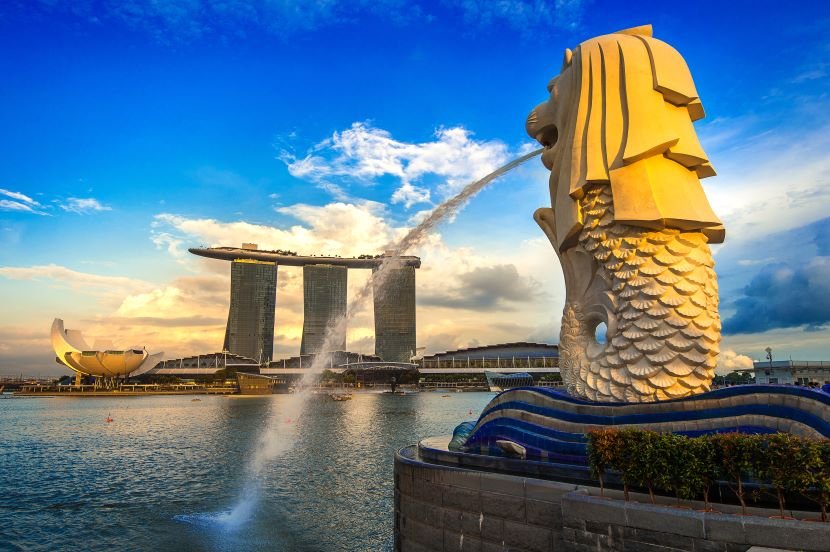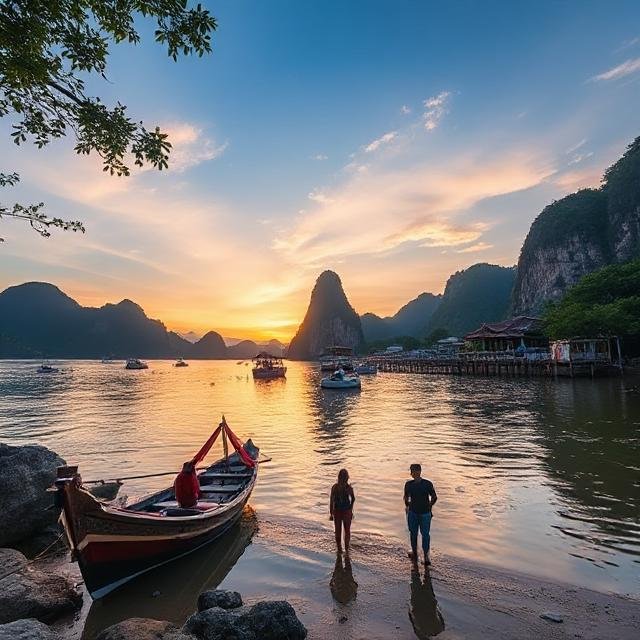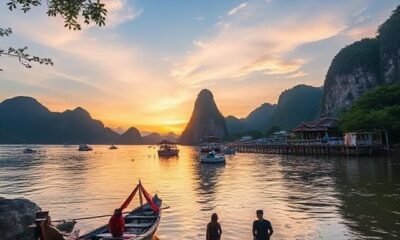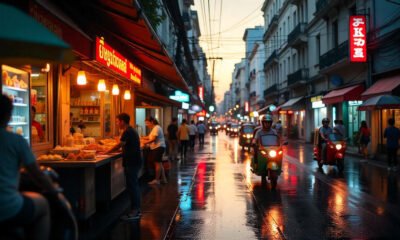Asia Travel Pulse
Singapore Strengthen Ties With India Through Cultural Tourism And Trade

Wednesday, August 6, 2025
With Singapore establishing itself as one of the top destinations globally, its tourism outreach to Indian travellers has seen substantial growth. With over 1.1 million visitor arrivals from India in 2023 and a 5.1% increase during the first five months of 2024, the island nation is experiencing a boom in tourism from one of its largest and fastest-expanding markets. The Singapore Tourism Board (STB) is capitalizing on this opportunity by curating cultural tourism experiences and forging stronger trade partnerships to enhance engagement with Indian travellers.
A Strategic Focus on Indian Travellers
The Indian market continues to play a pivotal role in Singapore’s post-pandemic tourism recovery. Data from the Singapore Tourism Board indicates that India has become the third-largest source market for the country, with over 1 million arrivals in 2023. By early 2024, the number of Indian visitors already exceeded half a million, marking a notable increase in tourism from India. STB has tailored its strategies to meet the growing aspirations of Indian travellers, who are increasingly seeking unique, high-value experiences in Singapore.
Repeat Visitors: A Sign of Success
One of the most significant indicators of success for Singapore in the Indian market is the rate of repeat visits. Over 40% of Indian visitors to Singapore are repeat travellers, reflecting a deep level of brand familiarity and satisfaction. This high return rate is not just a statistic but also a testament to Singapore’s ability to offer evolving experiences that resonate with Indian tourists. The STB is steering away from marketing Singapore as a one-time checklist destination, focusing instead on promoting the city-state as a return-worthy, lifestyle-oriented travel hub.
Innovative Engagement Strategies
The STB recently launched an innovative B2B roadshow series in India, designed specifically for the Indian market. These roadshows featured over 60 Singaporean tourism partners who showcased the latest developments and offerings from Singapore. Held in New Delhi and Kochi, the roadshow utilized a unique format, with dedicated experience zones that allowed tourism partners such as attractions, cruise lines, and destination management companies to present their services through immersive presentations.
As part of this campaign, the STB also introduced cultural elements, such as showcasing traditional Peranakan attire, to deepen emotional and cultural ties between the two nations. This is a symbolic gesture, aligning with the celebration of 60 years of India-Singapore diplomatic relations, and further solidifying Singapore’s cultural connections with its Indian audience.
Strengthening Connectivity Between India and Singapore
The ease of travel is another critical driver of tourism growth. Singapore now enjoys direct flight connections to 16 Indian cities, thanks to airlines such as Singapore Airlines, Vistara, Scoot, and IndiGo. This extensive flight network has enabled Singapore to penetrate Tier II and III Indian markets, tapping into high-spending outbound travellers. With just a four-hour flight from Mumbai, Singapore is positioned as the perfect weekend getaway destination for Indian travellers.
STB is also enhancing its visibility in India through campaigns with travel giants like IndiGo, Yatra, and TripAffiliate, as well as collaborating with celebrity influencers in its dedicated content creator program.
Focus on MICE Tourism
India’s significant contribution to Singapore’s MICE (Meetings, Incentives, Conferences, and Exhibitions) tourism has been especially pronounced in recent years. Singapore is set to host major MICE events in 2025, including a 6,100-delegate incentive trip from Sun Pharma and the CREDAI Natcon Convention’s debut Singapore edition. To build on this success, the STB has extended its popular “Just Between Us Friends” campaign to the MICE segment, offering Indian incentive groups exclusive perks such as benefits from Sentosa’s island partners and enhanced travel packages from IndiGo and Singapore Airlines.
In addition, the STB has introduced a new initiative called the “Singapore DMC Trade Partner Fam Support Scheme,” which will support Indian travel agents’ exposure to Singapore. This pilot program aims to inspire agents to curate more experience-rich itineraries for the Indian market.
Sentosa: A Key Attraction for Indian Visitors
Sentosa continues to be one of Singapore’s top attractions, particularly for Indian tourists. The island has seen an increase in the length of stay among Indian visitors, with family groups and solo travellers alike flocking to experience its unique blend of nature, culture, and leisure. In 2024, Sentosa introduced innovative experiences such as Sensoryscape, an interactive AR-infused thoroughfare, which has already attracted over 5 million visitors. Other attractions such as Harry Potter: Visions of Magic and Minion Land are also drawing significant interest from Indian tourists, especially families and millennial travellers.
For India’s high-net-worth individuals (HNWIs), Sentosa has launched Raffles Sentosa, an ultra-luxury all-villa property that is expected to appeal to this affluent segment. Additionally, new experiences like the Singapore Oceanarium promise high repeat value, with Indian visitors eager to return for more immersive and authentic encounters.
Diversified Offerings Beyond Sentosa
While Sentosa remains a primary focus, other destinations in Singapore are also attracting Indian visitors. Jurassic World, a thrilling experience at Gardens by the Bay, and Rainforest Wild Asia, Asia’s first rainforest-themed wildlife park, are among the new attractions that offer unique experiences. The Mandai Rainforest Resort by Banyan Tree, and Kada, a refurbished 100-year-old hospital turned lifestyle precinct, are also drawing attention for their chic cafés, pilates studios, and design boutiques.
These diversified offerings reflect Singapore’s commitment to catering to the evolving tastes of Indian travellers, who are increasingly seeking personalized, immersive, and culturally rich experiences.
Looking Ahead: Singapore’s Bright Future with Indian Travellers
Singapore’s strategic outreach to Indian travellers continues to yield impressive results, with increasing visitor numbers, a robust base of repeat visitors, and deepening cultural and cultural bonding. Through curated experiences, trade partnerships and better connectivity, Singapore is aiming to be the preferred destination for Indian luxury, adventure and lifestyle seekers. It is expected that Singapore’s cultural tourism will remain a premier destination highlight for Indian travellers.
Asia Travel Pulse
Thailand Aims to Revive Tourism as Chinese Visitor Numbers Plummet

Wednesday, August 6, 2025
Author: TTW News Desk
Tourism in Thailand, an important pillar of its economy, is having a tough year in 2025. International tourist arrivals have fallen 5%, led predominantly by a fall in visitors from China and competition from alternative destinations in Asia.
Between January 1 and July 5, 2025, Thailand received 16.8 million international visitors, lower than 17.7 million during the same period last year. The largest decrease was from neighboring nations, which dropped by 12.2%, with East Asia also experiencing a steep 24.8% decline. The main reason being the smaller number of Chinese tourists, which dipped by 34.2% from pre-pandemic 2019 levels.
Shifting Tourist Demographics
While long-haul travelers from markets like India, Japan, Singapore, Australia, and the U.S. have increased, their numbers remain relatively small, accounting for only 28% of total arrivals. These tourists typically spend more, but their growth cannot fully compensate for the loss of Chinese visitors.
Before the pandemic, China was Thailand’s largest tourism market, supplying 28% of all international arrivals—about 11.1 million visitors in 2019. However, Chinese tourists now make up just 13.6% of total arrivals. Estimates suggest that 2025 will mark the first time in over a decade (excluding COVID-19 years) that Chinese tourist numbers fall below 5 million.
Government Measures to Revive Tourism
Tourism contributes 20% of Thailand’s GDP, making its recovery crucial. The Thai government has introduced several initiatives to counter the downturn:
1. Delaying the Tourist Fee
Originally set for 2025, the government postponed the “Kha Yeap Pan Din” fee (a 300 THB charge for air arrivals and 150 THB for land/sea entries) to mid-2026. The funds will enhance tourist facilities and provide insurance coverage for foreign visitors.
2. Subsidies for Charter Flights
To attract more visitors, authorities are offering 350,000 THB per charter flight. New partnerships with travel agencies in Chongqing, Lanzhou, and Hangzhou aim to bring an additional 150,000 Chinese tourists to Thailand.
3. Digital Entry System
Earlier in 2025, Thailand launched a digital entry system, replacing paper-based immigration checks with a faster, online registration process to improve the traveler experience.
Factors Behind the Decline in Chinese Tourists
Several key factors contribute to the drop in Chinese visitors:
1. Economic Slowdown in China
China’s economic challenges, including a sluggish property market and weaker consumer spending, have led to reduced outbound tourism. Middle-class travelers, who once fueled Thailand’s tourism boom, are now more cautious with discretionary spending.
2. Rising Competition from Other Destinations
Countries like Vietnam, Japan, and South Korea have aggressively marketed themselves to Chinese tourists, offering easier visa policies and new attractions. Japan’s weakened yen, for example, has made it a more affordable option compared to Thailand.
3. Changing Travel Preferences
Post-pandemic, Chinese tourists are favoring shorter trips and domestic travel over long international vacations. The popularity of “revenge travel” within China has also diverted potential visitors away from overseas destinations.
4. Safety Concerns and Negative Perceptions
Reports of scams targeting tourists and safety incidents in Thailand have circulated on Chinese social media, damaging the country’s reputation as a secure destination. The Thai government is working to address these concerns through tighter regulations and public awareness campaigns.
Private Sector Initiatives in Thailand
Hotels, airlines, and tour operators are also adapting to the changing market:
- Discounts and Bundled Packages – Many resorts are offering all-inclusive deals to attract budget-conscious travelers.
- Luxury and Wellness Tourism – High-end hotels are focusing on medical tourism and wellness retreats, particularly targeting European and Middle Eastern visitors.
- Sustainable Tourism – Eco-friendly resorts and community-based tourism projects are gaining traction among environmentally conscious travelers.
Future Outlook for Thai Tourism
Experts are of the view that these stimulus steps will begin yielding fruit by the end of 2025. Assuming no serious disruptions, Chinese tourist arrivals may return to 70-80% of pre-pandemic levels towards the end of 2026.
Thailand, despite present difficulties, is a leading travel destination, and the efforts of the government seek to reinstate it as a player in the international tourism arena. The emphasis currently is on diversifying sources of visitors and improving traveler convenience in a bid to develop long-term growth.
Asia Travel Pulse
Thailand’s Tourism Strategy Must Evolve to Cater to The Growing Demand for Luxury Travel in Asia Pacific

Wednesday, August 6, 2025
Author: TTW News Desk
To cater to the region’s influx of high-net-worth travelers on the hunt for premium experiences, Thailand’s tourism playbook needs a makeover. Market data reveals a new wave of middle class consumers in key markets, such as China and India, who now crave high-end resorts, exclusive experiences and luxury services. Despite regulatory constraints, the Thai government is making efforts to stay competitive by allowing integrated resorts and putting a premium on infrastructure and public-private partnerships that would attract these big-spending tourists. This change is essential for the nation to take full advantage of the wealth in Asia Pacific and guarantee long-term prosperity amid an ever more fierce tourism industry.
The tourism industry in Thailand has for many years been among the largest in Southeast Asia, and this amount continues to expand every year. With visitor numbers exceeding that threshold (CNN puts it at 40 million), a marketplace is emerging for five-star luxury tourism — that sector poised to deliver the future growth, now that the country has arguably peaked as a traditional tourist destination. However, several leading experts have urged the country to aggressively target high-end travelers from the Asia-Pacific region — a fast-growing group of potential tourists who could be key to helping restore Thailand’s tourism industry. This transition requires a focused strategy such as luxury marketing, perception branding through public-private partnerships, and investment in global standard infrastructure.
Thailand’s Tourism Landscape and Challenges
In recent years, Thailand’s tourism industry has enjoyed tremendous success, attracting millions of international visitors annually. However, after surpassing the 40-million mark, Thailand now faces new challenges in maintaining its competitive edge in the global tourism market. To remain relevant in an increasingly competitive landscape, particularly in the Asia-Pacific region, Thailand must shift its focus towards luxury tourism.
This shift is necessary not only to keep up with the growing affluence of travelers in the region but also to maintain the country’s competitive position compared to neighboring destinations such as Singapore, Japan, and emerging destinations in the Middle East. Experts argue that Thailand’s tourism sector must focus on high-end travelers, particularly those from countries like China and India, whose growing middle class is fueling demand for premium travel experiences.
Affluent Travelers and the Rising Middle Class in Asia-Pacific
The Asia-Pacific region, which encompasses some of the world’s most dynamic economies, is witnessing an influx of affluent travelers who are increasingly looking for luxury experiences. According to the Pacific Asia Travel Association (PATA), tourism in Asia-Pacific generated over 648 million regional trips last year, with projections indicating that the number of trips will reach nearly 700 million this year and 800 million by 2027. Thailand, with its rich cultural heritage, vibrant cities, and tropical landscapes, is well-positioned to capture a share of this growing market.
China stands out as a crucial market driving the demand for luxury tourism. Over 6.2 million affluent individuals and 168 million upper-middle-class consumers in China are fueling luxury consumption, both within China and abroad. As these consumers look for travel experiences that cater to their refined tastes, Thailand stands out as a prime destination for high-end tourism, offering world-class resorts, luxurious beachfront properties, and exquisite dining experiences.
However, Thailand faces challenges in attracting these affluent travelers. A significant challenge is the perception of safety, particularly due to concerns over border scams and the recent tensions at the Thailand-Cambodia border. Many governments have issued travel warnings for Thailand, which has caused some hesitation among potential travelers from key markets like China. This perception issue has had a direct impact on the country’s ability to tap into the luxury tourism sector.
The Need for Luxury Marketing and Public-Private Partnerships
To maximize growth in the luxury tourism market, Thailand needs to invest in targeted luxury marketing campaigns that focus on the affluent Asia-Pacific traveler. The country must also work on strengthening public-private partnerships to develop new infrastructure and attractions that cater to the needs of high-end visitors.
Public-private partnerships can be key to building integrated resorts, luxury hotels, and entertainment complexes that appeal to the growing affluent class in the region. Additionally, these partnerships can foster the development of experiences that go beyond typical tourist attractions, offering exclusive and immersive experiences that luxury travelers crave.
Currently, Thailand’s major tourism websites, such as the Thailand National Tourism Organization’s (TAT) website, could benefit from significant upgrades. A more user-friendly and visually appealing website would make it easier for international visitors to access important information about the country’s luxury tourism offerings. By looking at the success of other national tourism boards, such as Japan’s National Tourism Organization website, Thailand could make improvements that would better showcase its luxury offerings to potential visitors from around the globe.
The Impact of Thailand’s Entertainment Complex Bill
Thailand’s entertainment complex bill, which remains delayed, is another factor that could affect the country’s ability to compete with other countries in the region. The bill’s approval is crucial for enabling Thailand to establish the necessary infrastructure to compete in the luxury tourism market. Integrated resorts and high-end entertainment complexes have become key attractions in places like Singapore and Macau. These resorts not only provide luxury accommodations but also offer world-class entertainment, dining, shopping, and leisure activities, creating a destination that appeals to affluent travelers.
Without this bill’s passage, Thailand risks falling behind other countries in the region. For example, developments like Singapore’s Marina Bay Sands and Sentosa, or Macau’s integrated resorts, continue to set the standard for luxury tourism in Asia. Additionally, new projects in emerging destinations such as Vietnam are gaining attention for their ability to attract affluent visitors, which could further increase the competitive pressure on Thailand.
Galaxy Resorts Thailand, for instance, has emphasized the need for the bill to be passed in order to enhance the country’s competitiveness. The resort giant has expressed patience regarding the delay, respecting the government’s decision while remaining hopeful that the legislation will eventually pass to allow for future developments.
Global Competitiveness and the Luxury Gaming Sector
The battle for dominance in the luxury tourism market extends beyond accommodations and entertainment. The gaming industry also plays a significant role in attracting affluent travelers, with several integrated resorts across the Asia-Pacific region catering to high-end gaming enthusiasts.
In Macau, for example, Galaxy Entertainment Group’s Galaxy Macau is set to open a fourth phase with five new luxury hotels, retail outlets, and family-friendly attractions. The resort is focused on attracting premium customers rather than mass-market gamblers, positioning itself as a high-end destination for tourists looking for both luxury gaming and non-gaming experiences.
With Macau’s government projecting a decrease in the region’s gross gaming revenue, Galaxy Entertainment is still optimistic about its business prospects, as it targets the premium gaming sector. Its strategy aligns with a broader trend in the industry, where companies focus more on high-value customers rather than the traditional mass market.
The Role of Integrated Resorts in Luxury Tourism
The concept of integrated resorts, which blend luxury accommodations, world-class entertainment, gaming, and retail, has become a key component of luxury tourism in Asia. Thailand has the potential to become a major player in this sector, but it will require the government and private sector to collaborate on the creation of world-class resorts that can attract affluent travelers from the Asia-Pacific region.
With the entertainment complex bill still under discussion, Thailand has not yet been able to capitalize fully on the integrated resort trend. However, as developments such as Japan’s MGM Osaka and the UAE’s first casino resort by Wynn in 2027 continue to emerge, the competition in this sector is becoming fiercer. Thailand needs to act quickly to secure its place in this rapidly expanding market.
Thailand’s Strategic Position in Asia-Pacific Tourism
Despite the current challenges, Thailand remains strategically positioned as a leading destination in the Asia-Pacific region. The country’s natural beauty, rich cultural heritage, and world-class infrastructure provide a solid foundation for luxury tourism development. However, Thailand must adapt to the changing demands of the Asia-Pacific tourism market by focusing on the luxury sector, particularly targeting the growing number of affluent travelers from China, India, and other regional markets.
To ensure its continued success in the luxury tourism market, Thailand must focus on marketing strategies that emphasize the country’s unique offerings and its potential for delivering world-class experiences. Building integrated resorts, improving tourism platforms, and passing the entertainment complex bill are essential for establishing Thailand as a top destination for wealthy travelers in the Asia-Pacific market.for affluent travelers in the Asia-Pacific region.
With the rise of luxury travel in Asia Pacific, driven by affluent travelers from markets such as China and India who are seeking once-in-a-lifetime high-end experiences, Thailand’s tourism strategy needs to adapt. Thailand has an opportunity to capitalize on its long-standing reputation as a tourism leader in Asia, but it will need to act quickly and invest in infrastructure, luxury resorts and public-private partnerships that build out the region if it is wants to stay at the head of the pack.
Luxury tourism in Thailand may be at a turning point. Safety remains a concern with the entertainment complex bill still unfinished, but the country needs to step up marketing efforts and take advantage of its rich pool of high-rolling visitor sources from Asia-Pacific. Thailand will become a key global player in the premium tourism market by developing public-private partnerships, rehabilitating infrastructure, and ultimately targeting luxury markets.
Asia Travel Pulse
Gilan’s Tourism Revolution: Explore The Cultural Heart Of Iran

Wednesday, August 6, 2025
Author: TTW News Desk
Nestled in northern Iran, Gilan province is quickly becoming an important player in the country’s tourism industry. Known for its rich historical and cultural heritage, Gilan has experienced a notable increase in both domestic and international visitors. The province features breathtaking natural landscapes and historical landmarks. It is also developing its tourism infrastructure to meet the growing demand. The appointment of the new head of Gilan’s Cultural Heritage, Tourism, and Handicrafts Department has reinforced the province’s goal of becoming a leading tourism destination.
At the introduction ceremony of the new head, Vahedi emphasized Gilan’s significant potential in tourism. The province holds an important place in Iranian tourism, with its mix of historical sites, cultural treasures, and beautiful scenery attracting millions of tourists each year. Vahedi pointed out the high expectations for Gilan, especially considering its exceptional assets and growth potential.
A Province Rich in Historical and Cultural Treasures
Gilan’s tourism attractions are varied, making it a distinct destination for travelers interested in Iran’s cultural and historical heritage. One popular spot is the village of Masuleh, known for its unique architecture and stunning hillside location. The village showcases Iran’s traditional architectural style, with homes stacked on top of each other and connected by narrow, winding paths that lead visitors through its distinctive layout.
The ancient Rudkhan Castle, also called Qale Rudkhan, is another major draw in Gilan. Built during the Seljuk period, the castle stands as a testament to the province’s rich history. Located on a hilltop surrounded by lush forests, the castle provides breathtaking views of the area and is a must-see for history enthusiasts and adventure seekers alike.
Alongside these iconic landmarks, Gilan is home to the Gilan Rural Heritage Museum, which offers an engaging look at the province’s rural life. The museum highlights traditional customs, crafts, and the lifestyle of its people. It promotes the preservation of Gilan’s traditions and enhances appreciation for its rich heritage.
Growing Tourism Infrastructure in Gilan
With its quickly expanding tourism industry, Gilan has become a key focus for investment. According to Vahedi, the province needs to prioritize developing its tourism infrastructure to fully utilize its potential. This includes creating more places to stay, improving transportation networks, and enhancing services for tourists. The provincial government has taken steps to ensure Gilan continues to prosper as a tourism hub. They are investing in infrastructure to provide a smoother and more comfortable experience for visitors.
One notable initiative is the designation of five percent of national budget assets for tourism development across provinces, including Gilan. This budget aims to help build world-class tourism infrastructure in Gilan, promoting growth in the sector and encouraging domestic and foreign investment in the region.
Despite recent challenges due to the Israeli war against Iran, Gilan’s tourism sector showed impressive resilience. The province welcomed six million visitors amid the tense situation, demonstrating the strength of its tourism offerings and its ability to ensure the safety and support of visitors even during difficult times. Local officials, private sector support, and the dedication of tourism workers made it possible for tourists to have a safe and enjoyable stay in the province.
The Role of the Private Sector in Gilan’s Tourism Boom
One of the notable aspects of Gilan’s recent tourism growth is the involvement of the private sector. During the crisis caused by the Israeli war, hotels, eco-lodges, and residences throughout Gilan opened their doors to visitors at significantly reduced rates, with some accommodations available for free. This initiative, which Vahedi called an “epic move,” not only offered much-needed relief for tourists but also strengthened the bond between the local community and visitors. The private sector’s role in tourism development has been vital in keeping Gilan an appealing and accessible destination for all types of travelers.
Key Attractions in Gilan Province
- Masuleh Village: Known for its unique stepped architecture and beautiful mountain views, Masuleh attracts visitors from Iran and abroad. Its peaceful atmosphere and historical significance make it a top choice for culture and history lovers.
- Rudkhan Castle: A historical gem dating back to the Seljuk period, Rudkhan Castle is perched atop a hill amid dense forests, providing sweeping views of the region. Its ruins offer a fascinating insight into Iran’s past.
- Gilan Rural Heritage Museum: This cultural treasure provides a deep dive into the traditional lifestyles, crafts, and culture of Gilan’s rural communities. Visitors can explore exhibits that highlight local art, clothing, and agricultural practices.
Looking to the Future: Gilan’s Tourism Potential
As Gilan continues to develop as a tourism destination, the future appears promising. The mix of historical landmarks, cultural richness, and scenic beauty, combined with the government’s commitment to improving infrastructure, positions Gilan as an important player in Iran’s tourism industry. The province’s focus on attracting investors and creating a welcoming environment for visitors will certainly contribute to its ongoing success in tourism.
With the rising number of visitors to Gilan, the province is poised to maintain its momentum, bolstering its reputation as one of Iran’s most desirable tourism spots. Whether exploring tranquil villages, hiking in lush mountains, or immersing oneself in the region’s deep cultural roots, Gilan offers something for every traveler.
Conclusion: Gilan’s Bright Future in Tourism
Gilan’s rise as a tourism powerhouse highlights the province’s great potential and the dedicated efforts of both public and private sectors to offer an unforgettable experience for travelers. With ongoing investment and continued infrastructure development, Gilan is sure to solidify its status as a leading tourist destination in Iran. As the province evolves and grows, visitors can look forward to an ever-improving experience that combines the charm of its historic sites with the beauty of its landscapes. Gilan’s tourism industry is set for a bright future, providing endless opportunities for exploration and investment.
(Source: Gilan Cultural Heritage, Tourism and Handicrafts Department, Miras Arya, Iranian government, tourism sector, Gilan province, Masuleh village, Rudkhan Castle, Gilan Rural Heritage Museum, Iranian Parliament, tourism infrastructure development, private sector tourism support, Gilan tourism growth)
-

 Brand Stories2 weeks ago
Brand Stories2 weeks agoBloom Hotels: A Modern Vision of Hospitality Redefining Travel
-

 Brand Stories2 weeks ago
Brand Stories2 weeks agoCheQin.ai sets a new standard for hotel booking with its AI capabilities: empowering travellers to bargain, choose the best, and book with clarity.
-

 Destinations & Things To Do2 weeks ago
Destinations & Things To Do2 weeks agoUntouched Destinations: Stunning Hidden Gems You Must Visit
-

 Destinations & Things To Do2 weeks ago
Destinations & Things To Do2 weeks agoThis Hidden Beach in India Glows at Night-But Only in One Secret Season
-

 AI in Travel2 weeks ago
AI in Travel2 weeks agoAI Travel Revolution: Must-Have Guide to the Best Experience
-

 Brand Stories1 month ago
Brand Stories1 month agoVoice AI Startup ElevenLabs Plans to Add Hubs Around the World
-

 Brand Stories4 weeks ago
Brand Stories4 weeks agoHow Elon Musk’s rogue Grok chatbot became a cautionary AI tale
-

 Brand Stories2 weeks ago
Brand Stories2 weeks agoContactless Hospitality: Why Remote Management Technology Is Key to Seamless Guest Experiences
-

 Asia Travel Pulse1 month ago
Asia Travel Pulse1 month agoLooking For Adventure In Asia? Here Are 7 Epic Destinations You Need To Experience At Least Once – Zee News
-

 AI in Travel1 month ago
AI in Travel1 month ago‘Will AI take my job?’ A trip to a Beijing fortune-telling bar to see what lies ahead | China













You must be logged in to post a comment Login